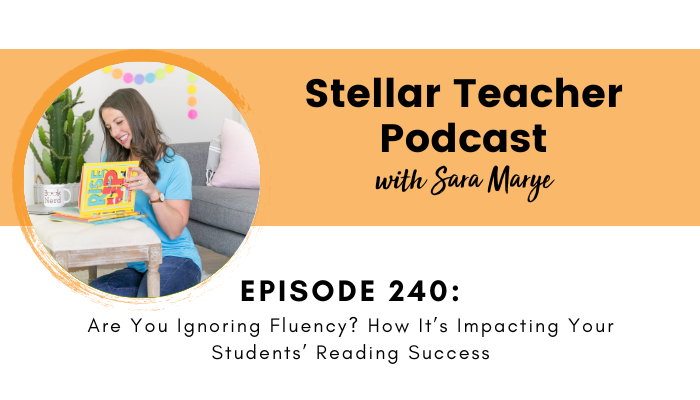
Click play below to listen to the impact fluency can have on your students’ reading success.
If you’ve ever wondered whether fluency instruction still matters in upper elementary, this episode is for you! Many teachers assume fluency is something students master in the early grades, but the truth is, fluency plays a critical role in reading success at every stage. In this episode, we’re diving into why fluency is the bridge between decoding and comprehension—and why it deserves just as much attention in third, fourth, and fifth grade as it does in K–2.
Fluency is more than just reading fast. It’s about reading with accuracy, appropriate pacing, and expression—all of which help students fully understand what they read. Without strong fluency skills, students often struggle with comprehension, and those gaps can persist well into middle and high school. That’s why today’s conversation is all about making fluency a priority in upper elementary and finding simple, effective ways to incorporate fluency practice into your literacy block to set students up for reading success.
If you’ve noticed that some of your students read too slowly, skip words, or sound robotic when reading aloud, this episode will give you the tools to help them improve. We’ll discuss why fluency is essential, common fluency challenges in upper elementary, and a structured five-day fluency routine that you can easily implement in just a few minutes a day. With these strategies, you can boost your students’ confidence, comprehension, and overall reading success. Let’s jump in and make fluency a key part of your reading instruction!
In this episode on how fluency can impact your students’ reading success, I share:
- Why fluency is often overlooked in upper elementary and why it should be a priority in your literacy instruction.
- The three key components of fluency—accuracy, rate, and expression—and how they contribute to comprehension.
- How fluency acts as a bridge between word recognition and reading success.
- Why fluency challenges in upper elementary students may actually be the root cause of comprehension struggles.
- A simple, structured five-day fluency routine that only takes 5–10 minutes a day but yields big results.
- Practical ways to incorporate fluency instruction into your literacy block without adding extra planning or stress.
Resources:
- Join The Stellar Literacy Collective
- Sign up for my Private Podcast: Confident Writer Systems Series
- Sign up for my FREE Revision Made Easy email series
- If you’re enjoying this podcast, please leave a review on Apple Podcasts!
Related Episodes and Blog Posts:
- Episode 235, 3 Powerful Routines to Boost Reading Comprehension in Your Classroom
- Episode 203, 5 Strategies for Improving Reading Fluency in your classroom (SOR Summer Series Part 4)
- Episode 190,Navigating the Complexities of Sentence Structure
Connect with me:
- Join my newsletter
- Shop my TPT store here
- Instagram: @thestellarteachercompany
- Facebook: The Stellar Teacher Company
More About Stellar Teacher Podcast:
Welcome to the Stellar Teacher Podcast! We believe teaching literacy is a skill. It takes a lot of time, practice, and effort to be good at it. This podcast will show you how to level up your literacy instruction and make a massive impact on your students, all while having a little fun!
Your host, Sara Marye, is a literacy specialist passionate about helping elementary teachers around the world pass on their love of reading to their students. She has over a decade of experience working as a classroom teacher and school administrator. Sara has made it her mission to create high-quality, no-fluff resources and lesson ideas that are both meaningful and engaging for young readers.
Each week, Sara and her guests will share their knowledge, tips, and tricks so that you can feel confident in your ability to transform your students into life-long readers.
Tune in on your favorite podcast platform: Apple, Google, Amazon, Spotify, Castbox, and more! If you’re loving this podcast, please rate, review, and follow!
Podcast (stellar-teacher-podcast): Play in new window | Download
Today, we’re talking about something that I think is often overlooked in upper elementary—fluency. Now, if you’re a third, fourth, or fifth-grade teacher, you might be thinking, Fluency? Isn’t that something that’s focused on in the early grades? Well, stick with me, because by the end of this episode, I think you’re going to see why fluency is just as important in upper elementary as it is in K–2.
Hey there, Stellar Teacher! Welcome back to the podcast, and thanks for joining me today. I know that I am very selective when it comes to the podcasts and audiobooks I choose to listen to, so it always means so much to me to know that you tune in each week to this podcast.
When I’m putting these episodes together, I always envision sitting down with some of my teacher friends and just chatting about literacy topics. So today, let’s chat about fluency.
Let’s start with a quick definition—what is fluency? Fluency is the ability to read accurately, at an appropriate rate, and with expression.
I know that when I first started teaching, I was a second-grade teacher, and in my very first classroom, I often put way too much emphasis on the appropriate rate—aka speed—aspect of fluency. I worked at a school that used DIBELS as one of its assessments, so that words-per-minute rate was really important. But the goal of fluency is not just for students to become speed readers or to get a high score on a DIBELS assessment or any fluency assessment, right?
The end goal of fluency is not necessarily fluency itself. The true goal of fluency is to make it easier for students to comprehend what they read.
I think it’s always important for us to remember that the ultimate goal of all literacy instruction is for students to be able to comprehend what they read independently. Fluency is often described as the bridge between word recognition and comprehension. It’s important that we don’t think of fluency as its own separate entity but rather recognize the role it plays in helping students become skilled readers.
When students struggle with fluency, they spend so much mental energy decoding words that they have very little left to actually understand what they’re reading. But when students are fluent readers, their brains can focus on making meaning of the text—which is the ultimate goal of reading.
So, I think we can all agree that fluency is an important part of helping students become skilled readers. But whose job is it to teach fluency?
In upper elementary, we often think of fluency as something that happens in K–2—a primary-grade thing. And yes, it is a primary-grade focus, but whether or not you emphasize fluency really has nothing to do with what grade you teach—it comes down to the needs of your students.
Back in the fall, when I attended The Reading League conference, one of the speakers was talking about phonics instruction, and she said, You don’t age out of phonics, you skill out of it. I loved that phrase because it reinforces the idea that we don’t stop teaching phonics when students reach a certain age—we stop when they have the phonics skills they need to be successful readers.
The same is true of fluency. Age has nothing to do with it. If you have students in your class who aren’t able to fluently read grade-level texts, then you need to focus on fluency.
And really, since texts continue to become more complex each year, I think an argument could be made for focusing on fluency in every grade.
Last month, we hosted our Comprehension Reset Challenge, and one of the biggest surprises was how many teachers shared that they weren’t actively teaching or practicing fluency in their classrooms. This was because they assumed that once students reached third, fourth, or fifth grade, they should already be fluent and that their focus should shift entirely to comprehension.
But here’s the thing we really emphasized during the challenge—fluency is necessary for comprehension. Students can’t understand what they read unless they’re able to read it fluently, accurately, at an appropriate rate, and with expression.
So if you feel like your students are struggling with comprehension, double-check their fluency. It might not actually be a comprehension issue; it might be a fluency issue. And we really can’t assume that fluency will develop on its own.
In upper elementary, we still have a lot of students who read too slowly, which means they can’t keep up with grade-level content. We also have students who read inaccurately, often skipping words and missing meaning, which makes it difficult for them to extract information from the text. And then, we have students who read in a robotic, monotone way, which tells us they aren’t engaging with the text or understanding the tone and mood of what they’re reading.
All of these fluency issues impact a student’s comprehension. And if we don’t explicitly teach fluency, some of our students will struggle all the way through middle school and into high school. This ultimately affects their confidence, their academic success, and even their ability to read for enjoyment. So yes, fluency really does matter in upper elementary.
Recently, I was reading a book by Tim Rasinski to prepare for this episode. He’s a fluency guru and has published numerous articles and books all about fluency. One of the things he mentioned is that most reading programs don’t have a structured fluency component.
I want you to take a minute and think about the program or curriculum your school provided. Does it have a structured fluency component?
When I reflected on my own teaching experience, I realized that none of the boxed curricula I was given had any sort of structured fluency practice component. I know that when I taught second grade at a school that used DIBELS, we assessed fluency, but we didn’t have a plan to improve it.
I remember administering the DIBELS assessment three times a year, but in between those assessments, I had no idea what I should have been doing to help my students become more fluent readers. If I had the knowledge I have now, that wouldn’t have been a problem. Even if my curriculum lacked a structured fluency component, I would have had the knowledge and strategies to improve my students’ fluency.
But when I first started teaching, I definitely didn’t understand so many things about literacy. And I think that serves as an important reminder—educators can’t rely solely on boxed curricula to guarantee that everything our students need is included, because sometimes it isn’t.
Now, if you’re a member of the Stellar Literacy Collective, you can rest assured that the resources you receive in the membership do support fluency. We have a very intentional fluency component built into our third, fourth, and fifth-grade whole-group lessons. Because, as I said, we now know how important fluency is, especially in upper elementary.
But even if you are a member of SLC, having extensive literacy content knowledge is incredibly powerful. Because when you have that knowledge, even if your curriculum is missing something, you can supplement. You can structure your classroom in a way that guarantees your students get the practice they need in all literacy areas.
So when you’re thinking about fluency practice, there are three key things to consider: the text, the practice, and the time of day.
First, what are your students going to read to improve their fluency? There are a few guidelines to keep in mind when selecting a text for fluency practice.
You want it to be slightly challenging for your students. If a text is too easy and students can already read it fluently, they won’t have the opportunity to improve their fluency.
At the same time, you want the text to be meaningful. We really want to move away from selecting random texts just for skill practice. Instead of choosing a text simply because it works for fluency practice, think about how that text can connect to something else.
So when thinking about a text for fluency, consider whether you could use an excerpt from a chapter book that you’re currently reading. Is there a paragraph or a section of dialogue that you could pull out and use to practice fluency? Could you find a short text on the same topic as something you’re studying in science or social studies so that your students are building additional background knowledge? We really want to connect the topic of fluency practice to something else students are already familiar with because, like I said, it makes it more meaningful and gives it more purpose.
And finally, the last thing to consider when selecting a text for fluency practice is variety. The goal of fluency practice is to equip students to read a variety of texts, so we want them to practice with a range of genres and styles. Be intentional about switching up the type of texts used for fluency practice. Students should work with informational texts, stories, poems, speeches, and texts with dialogue. Just don’t get stuck in a rut of always using the same type of text for fluency practice.
Now, let’s talk about the practice. What are your students actually going to do to improve their fluency? There are several fluency scaffolds you can put in place to help improve your students’ fluency. You don’t necessarily want students to just read the text by themselves all week, and you also don’t have to make every fluency practice session a timed fluency test. I know that sometimes we time students to measure their words per minute, especially when preparing for assessments like DIBELS, but we don’t want every fluency session to feel like a high-pressure test. When students feel rushed, they often neglect other important aspects of fluency, like expression and phrasing.
Instead, we need to be strategic about how we build fluency, and scaffolding can help. I know time is always tight in an upper elementary literacy classroom, so I want to share a simple five-day fluency routine that you can easily incorporate into your existing literacy block. This routine only takes five to ten minutes a day, provides repeated practice with the same text throughout the week, and engages students in different fluency scaffolds.
Now, keep in mind, you can modify this to fit your schedule. If you only have four days, you can remove one of the steps. If one of the scaffolds doesn’t resonate with your students, you can swap it out for something they enjoy. You have flexibility.
To start, you’ll select one text for the entire week.
On Monday, model fluent reading by reading the text out loud. Demonstrate accuracy, expression, and appropriate pacing. You can have students practice reading the text along with you or by themselves after you model it.
On Tuesday, engage in choral reading as a class. Reading the text together builds students’ confidence and helps them develop rhythm.
On Wednesday, have students practice partner reading. Pair students up and have them take turns—one student reads while the other listens and provides feedback, or they can read together. Both approaches help build fluency.
On Thursday, do echo reading. Read a line aloud and have students repeat it back, focusing on expression and phrasing. Instead of you reading the line, you could also have a student model the reading while the rest of the class echoes.
On Friday, wrap up the fluency routine with a performance reading and self-assessment. Have students read a short excerpt to a partner or a small group. If you have a buddy classroom, they can read it to a younger reading buddy. Then, have students reflect on their fluency by considering aspects like expression, phrasing, and accuracy. The self-assessment piece is powerful because it encourages students to become more aware of their fluency skills and how they can improve.
This routine is simple, structured, and effective. And since it only requires one text for the whole class, you don’t have to worry about finding different fluency passages for various groups of students.
Okay, the last thing to consider when planning out your fluency practice is the time of day. When can you incorporate fluency into your literacy block? The good news is that fluency practice can happen anytime. If you use a routine like the one I just mentioned, it doesn’t have to take up a lot of time. Many teachers who implemented this fluency routine during our Comprehension Reset Challenge shared how simple it was to incorporate and how surprised they were by how much they could accomplish in just five minutes of practice.
Maybe you want to do your fluency practice as part of your morning meeting, first thing in the morning when students walk in. Maybe you integrate it into your whole group lessons. It could be something that students work on with partners while you pull a small group. And since every day of the routine is different, you can get creative and fit it into different parts of your literacy block on different days. The important thing is that you prioritize fluency and make time for it. You don’t necessarily have to find extra time or carve out new time slots—you just have to make it a priority.
If we don’t explicitly teach fluency, some of our students will struggle with reading much longer than they should. It’s important to remember that students with poor fluency often end up reading below grade level for years. They also struggle to keep up in content-heavy subjects like science and social studies, which can lead to frustration and an avoidance of reading for pleasure. Additionally, they may have difficulty with standardized tests that require reading long passages. I know I don’t want that for your students, and I know you don’t want that for them either.
I really hope that today’s episode has helped you see just how important fluency is, and that you now have a few practical ways to fit it into your schedule.
Now, one last thing before we wrap up—if today’s episode resonated with you, or if any of the episodes we record resonate with you, I would love for you to share this podcast with a fellow teacher. Send it in a quick text to your co-teacher, email it to your grade-level team, or post about it on Instagram—and don’t forget to tag us! Word-of-mouth recommendations are one of the best ways to help more teachers discover this podcast, and since you tune in each week, I know this show is important to you. So let’s spread some literacy love and empower even more educators together. I’ll see you back here next Monday!
Thanks so much for joining me today. If you enjoyed this episode and are finding value in this podcast, it would mean the world to me if you subscribed and left a five-star positive review. This helps me spread the word to more and more teachers just like you. Don’t forget to join me over on Instagram @thestellarteachercompany, and you can also find links and resources from this episode in the show notes at stellarteacher.com.
I’ll see you back here next week!

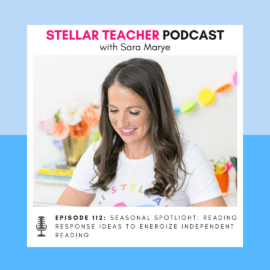
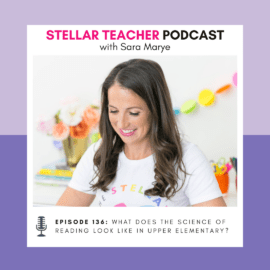
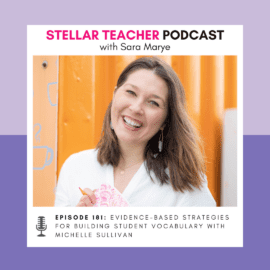
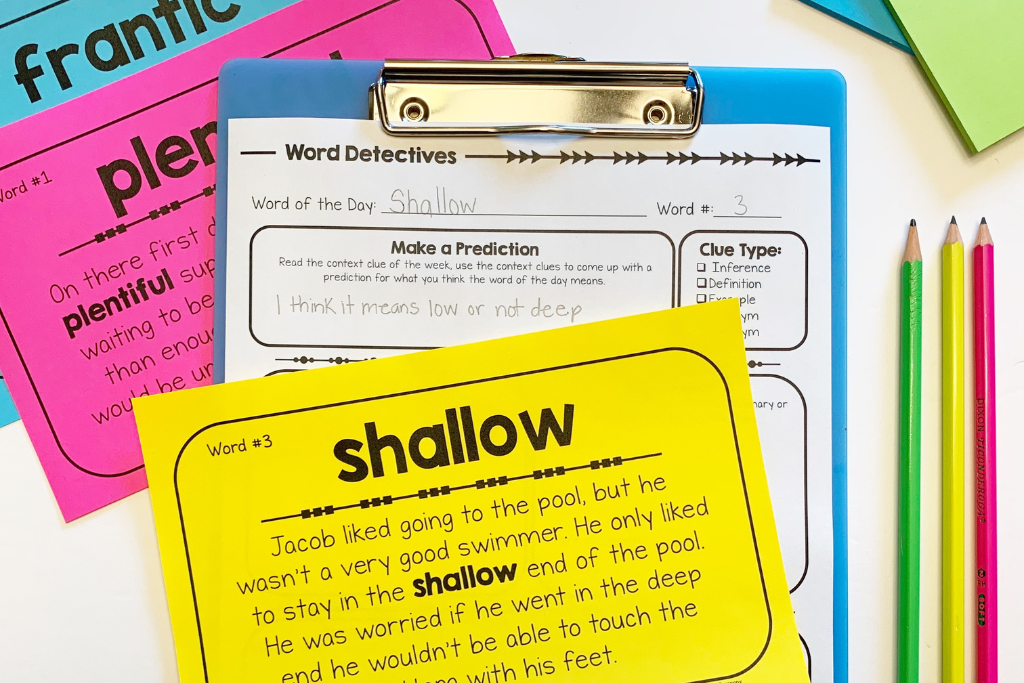

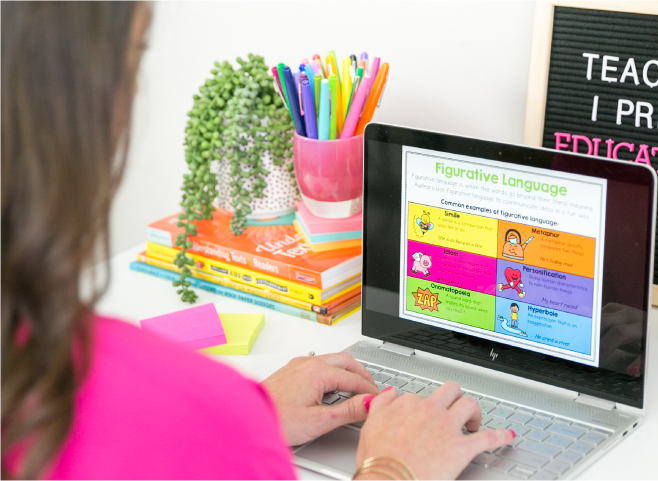

Leave a Comment
You must be logged in to post a comment.